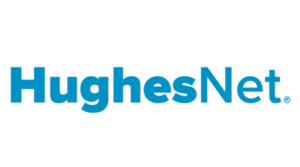Below is only a sample of our business Internet provider partners. Request a quote and we will search our database of hundreds of providers and arrange for the best proposal to meet your requirements.
Business Internet Providers in the USA
In 10 US states
Verizon business Internet
- Up to 940 Mbps
- Symmetric fiber speed
- For all business sizes
- Business digital voice
In 6 US states
Frontier business Internet
- Up to 100 Mbps
- Symmetric fiber speed
- For small businesses
- Business Wi-Fi
In 21 US states
AT&T business Internet
- Up to 1Gb/s
- Symmetric fiber speed
- For all business sizes
- Long distance voice
In 21 US states
Earthlink bus. Internet
- Up to 1 Gbps
- Symmetric fiber speed
- For small businesses
- Other Internet services
In all US states
Hughesnet bus, Internet
- Up to 25 Mbps
- Satellite broadband
- For rural businesses
- Digital voice services
There are over 2,500 Internet Service Providers (ISPs) in the USA enabling the whole population to have access to the Internet. However, for most businesses, Internet access has to meet certain minimum requirements that cannot easily be met by all Internet access services. This guide introduces businesses, especially small businesses, to the leading business Internet providers of the most popular wireline Internet access technologies – Ethernet over Fiber (EoF), business cable or Hybrid Fiber Coaxial (HFC), and T1 and bonded T1 lines (T1 and nT1). The most important attributes to consider when selecting a provider are discussed.
We hope that through this guide you can make more informed decisions when shopping for Internet connectivity solutions. Please note that the focus here is on wireline access although wireless access solutions.
Important considerations when shopping for business Internet solutions.
 Pricing
Pricing
Price is one of the most important considerations for businesses in the market for Internet access solutions. Our price guidelines for different Internet types show wide ranges in price for solutions that appear to be similar, demonstrating that too many factors go into pricing a service. It is very important to evaluate pricing against important features of the Internet service. It is often the case that the lowest cost service leads to frustrations when performance requirements are not met. The rest of the specifications below should be thoroughly reviewed and matched against your requirements before negotiating a price.
While we have access to pricing information for most business Internet providers in America, it is impossible for us to list all of them here because of the large permutations of factors involved in pricing plans. These factors include, but are not limited to, Internet speed, quality of service, geographic location and competition. Fortunately, with GeoQuote, you can search pricing quotations for services in your area that match your requirements. Send us a request for quotation.
 Internet speed
Internet speed
Internet speed is the most referenced attribute when businesses request a quotation for services from business Internet providers. Without taking in consideration the attributes discussed in this guide, Internet speed can turn out to be a meaningless specification. 1 Gigabit/s, for example, can refer to both non-dedicated and asymmetric cable broadband access at 1 Gigabit/second(download) x 35Megabit/second (upload) and dedicated and symmetric Ethernet over Fiber service at 1 Gigabit/second(download) x 1 Gigabit/second(upload). These two are completely different services offering different performance levels and are priced very differently. While the former is cheap, it might not meet requirements of some critical business applications.
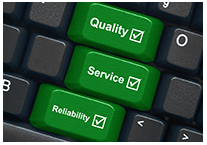 Quality of Service (QoS) guarantees
Quality of Service (QoS) guarantees
One distinguishing feature of business Internet access from consumer broadband access is Service Level Agreement (SLA). Service level agreement defines the level of service the provider promises to deliver and the remedies applicable should the service not meet the promised levels. Quality of service guarantee is an important element of any SLA. The provider will guarantee one or more of quality attributes including uptime or availability, latency, jitter or packet loss.
 Availability
Availability
Availability is the probability that the Internet service will be functional at any given time. Business Internet providers typically specify availability as a percentage of the time the service is up and running. Typical business Internet availabilities range from 99.5% to 99.999% (the so called 5 9s). 99.5% availability is equivalent to 44 hours of likely Internet downtime in a year. While such availability is more than sufficient for routine Internet access and checking email, it is unacceptable for many other business applications such as connecting a web or mail server. 99.999% availability is equivalent to only 5 minutes of potential downtime in a year. Needless to say, the ideal availability is 100% which is not easy to achieve. Businesses can get almost 100% availability by having a redundancy scheme which includes a second dedicated Internet access solution using another high availability Internet service provider. The higher the availability guarantee, the more costly the business Internet service is.
 Latency
Latency
Latency is the time it takes an IP packet to travel between the sender and the receiver. The distance between the sender and the receiver and the equipment (such as routers) that data passes through contribute to latency. Satellite broadband over geostationary satellites, for example, is subject to latency of a least 540 milliseconds due to the data trip from earth to the satellite and back again. Newer satellite systems such as Low Earth Orbit (LEO) and Medium Earth Orbit (MEO) have significantly improved latencies. On the other hand, optical fiber only contributes 3.34µs per fiber kilometer.
Applications such as gaming, VoIP, video conferencing and high frequency trading are very vulnerable to latency. Most high frequency traders seek to collocate their service with stock exchanges to reduce latency between their servers and the exchange.
 Packet loss
Packet loss
Packet loss occurs when Internet packets fail to reach their intended destination. It is defined as the percentage of the number of packets lost to the number of packets sent. Packet loss manifests itself as a disruption in the network, slow service or even loss of connectivity or downtime. Mobile broadband is especially prone to packet loss because of network congestion. Real time applications such as VoIP, gaming and video streaming are most vulnerable to packet loss.
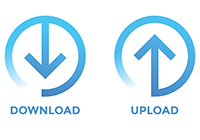 Symmetric/Asymmetric Internet access
Symmetric/Asymmetric Internet access
A symmetric Internet service is one for which the download speed equals the upload speed. An asymmetric service, on the other hand, is one that allows more download speed than upload speed. When bandwidth is limited, business Internet providers design their services to offer more bandwidth for download considering that most consumers spend more time downloading than uploading data. However, for many business applications, uploading data is as important as downloading it. Digital subscriber lines, cable and mobile broadband are typically asymmetric while carrier Ethernet services and T1 lines are symmetric.
When a business Internet provider offers you a deal for 100Mbps (say), take some time to find out if it is symmetric or asymmetric. In other words, find out what the upload speed is.
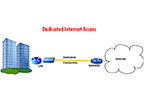 Dedicated Internet
Dedicated Internet
A dedicated Internet connection between a subscriber and an Internet access provider can either be dedicated or not. A dedicated Internet connection offers bandwidth exclusively for the subscriber – there is no sharing of bandwidth with other subscribers on the same node. If a dedicated Internet subscriber has a 100Megabit/second connection, they are guaranteed this level of bandwidth at all times. Most businesses opt for dedicated Internet access such as carrier Ethernet and T1 lines.
On the other hand, most mass market broadband services such as 4G mobile broadband, DSL and cable are shared services. The provider recons that consumer Internet users are not always on the Internet and they design the network so that bandwidth can be shared. With such services, you experience the maximum speed when no one else is on the Internet but the speed can drastically fall when everybody on your node is online.

Service installation
The installation required for your service can make a huge difference to the time required to turn on service and the overall upfront cost. If business Internet providers already have service in your building then the installation time and cost can be minimal. However, if you have to install fiber based services for the first time, you have to do a lot of homework and prepare your premises for installation and limit the amount of time the provider’s engineer has to be at your premises. The longer they will take to do the installation, the more you will pay.
While business Internet providers and customer premises are all unique, there are certain things you can start working on before you even request a quotation. Remember, before we can get you a quotation for some services, an engineer has to visit your site to do a survey.
- Find out which business Internet providers are already connected to your building. If no provider is already in the building, find out their nearest points of presence. This information can be provided free of charge through our Fiber Lit Building service. If installation requires running fiber from a point of presence to your building, you want to make sure that you request quotations from providers with the nearest point of presence to your building.
- Is there a building conduit?
- Is there a building telecommunications room demarcation point?
- Do you have a building telecommunications room with power supply?
- Do you already have fiber optic based Local Area Network (LAN) connections in the building?
When an engineer visits you for a site survey, they may also recommend things that you should work on to prepare for the installation.
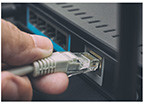 Is a router or Customer Premises Equipment (CPE) included?
Is a router or Customer Premises Equipment (CPE) included?
A price quotation may or may not indicate whether a router or CPE is included. While some providers include the equipment in their pricing, some will rent it to you while others may expect you to purchase your own. Knowing this ahead of time will ensure that your budgeting is accurate. The onus is on you to ask.
 Loop and port charges
Loop and port charges
On your quotation you might find two charges – one for port and the other for loop. Loop refers to the local loop or access network that connects your building to your network provider. The port refers to the service you are subscribing to, whether it is Ethernet, T1 etc. If your Ethernet over Fiber provider is AireSpring, for example, they may connect you via the local loop provider in your area, such as Verizon. The loop cost will then be the price component payable to Verizon while the port component is payable to AireSpring. Since your provider is AireSpring, they will seamlessly handle all the billing, support and any other issues that you may have. FCC regulations require that the port and loop components be shown separately in the billing. If a provider, say CenturyLink, provides end to end connectivity to your building, you may still notice a loop cost of $0 in the quotation.
 Bundled services
Bundled services
Business Internet providers oftentimes offer bundled services including fixed IP addresses, email addresses, web hosting and business phone system. Check all that is included and put that in consideration as you negotiate pricing.
 Contract terms
Contract terms
For most business Internet providers, the cost of the connectivity solutions are usually impacted by contract terms which range from 1 year to 5 years (typically 1 to 3 years). The longer the contract term, the lower is your monthly rate.
 Ethernet over Fiber business Internet providers
Ethernet over Fiber business Internet providers
Price Guide: $300 to $13,000
Installation: $0 to $1,800
Contract terms: 1 to 5 years
Ethernet over Fiber is the transmission of Ethernet services over long distances using optical fiber. Unlike Ethernet in the LAN, Ethernet over Fiber is used to transmit high bandwidth of data over 10s of kilometers of fiber.
The success of Ethernet in the LAN and its well-known advantages such as low cost/bit, flexibility and ubiquity pushed the industry to develop Ethernet standards for the Wide Area Network (WAN). The use of Ethernet in the WAN is typically marketed as carrier Ethernet. Almost all fiber network providers in the GeoQuote carrier research tool offer carrier Ethernet services for many applications, including Internet connectivity.
If your building is already connected by fiber, chances are that Ethernet over Fiber is already available to you. If you are not directly connected, it will take additional installation of a link from your building to the nearest provider’s Ethernet point of presence.
The Ethernet over Fiber Internet offers the most bandwidth, flexibility and reach of most Internet services. Typical bandwidth range from 10 Megabit/second x 10 Megabit/second to 1 Gigabit/second x 1 Gigabit/second with 10 Gigabit/second x 10 Gigabit/second available in a limited number of markets. Businesses requiring higher bandwidth should consider wavelength services capable of up to 100Gigabit/second per wavelength.
| Provider | Min Speed | Max speed | States covered |
|---|---|---|---|
| CenturyLink | 10Megabit/s x 10Megabit/s | 1Gigabit/s x 1Gigabit/s | Alabama, Alaska, Arizona, Arkansas, California, Colorado, Connecticut, Delaware, District of Columbia, Florida, Georgia, Hawaii, Idaho, Illinois, Indiana, Iowa, Kansas, Kentucky, Louisiana, Maine, Maryland, Massachusetts, Michigan, Minnesota, Mississippi, Missouri, Montana, Nebraska, Nevada, New Hampshire, New Jersey, New Mexico, New York, North Carolina, North Dakota, Ohio, Oklahoma, Oregon, Pennsylvania, Puerto Rico, Rhode Island, South Carolina, South Dakota, Tennessee, Texas, Utah, Vermont, Virgin Islands, Virginia, Washington, West Virginia, Wisconsin, Wyoming |
| Airespring/Verizon | 10Megabit/s x 10Megabit/s | 1Gigabit/s x 1Gigabit/s | Delaware, District of Columbia, Pennsylvania, Maryland, Massachusetts, New Jersey, New York, Pennsylvania, Rhode Island, Virginia |
| AT&T Business | 1Megabit/s x 1Megabit/s | 1Gigabit/s x 1Gigabit/s | Alabama, Arkansas, California, Florida, Georgia, Illinois, Indiana, Kansas, Kentucky, Louisiana, Michigan, Mississippi, Missouri, Nevada, South Carolina, Ohio, Oklahoma, North Carolina, Tennessee, Texas, Wisconsin |
| Frontier | 10Megabit/s x 10Megabit/s | 1Gigabit/s x 1Gigabit/s | Alabama, Arizona, California, Connecticut, Florida, Georgia, Idaho, Illinois, Indiana, Iowa, Michigan, Minnesota, Mississippi, Montana, Nebraska, Nevada, New Mexico, New York, North Carolina, Ohio, Oregon, Pennsylvania, South Carolina, Tennessee, Texas, Utah, Washington, West Virginia, Wisconsin, |
| Windstream | 10Megabit/s x 10Megabit/s | 100Megabit/s x 100Megabit/s | Alabama, Arkansas, Delaware, Florida, Georgia, Indiana, Iowa , Minnesota, Missouri , New Mexico , New York, North Carolina, Ohio, Oklahoma , Pennsylvania, South Carolina , Texas |
| EarthLink | 10Megabit/s x 10Megabit/s | 1Gigabit/s x 1Gigabit/s | Alabama, Arizona, Arkansas, California, Colorado, Connecticut, Delaware, District of Columbia, Florida, Georgia, Idaho, Illinois, Indiana, Iowa, Kansas, Kentucky, Louisiana, Maryland, Massachusetts, Michigan, Minnesota, Mississippi, Missouri, Montana, Nebraska, Nevada, New Jersey, New Mexico, New York, North Carolina, Ohio, Oklahoma, Oregon, Pennsylvania, Rhode Island, South Carolina, South Dakota, Tennessee, Texas, Virginia, Washington, Wisconsin, Wyoming |
| Google Fiber | 10Megabit/s x 10Megabit/s | 1Gigabit/s x 1Gigabit/s | Alabama, California, Georgia, Kansas, Kentucky, Missouri, North Carolina, Tennessee, Texas, Utah |
| Consolidated Communications | 10Megabit/s x 10Megabit/s | 1Gigabit/s x 1Gigabit/s | California, Illinois, Pennsylvania, Texas |
| Megapath | 10Megabit/s x 10Megabit/s | 1Gigabit/s x 1Gigabit/s | Arizona, Connecticut, Delaware, Florida, Indiana , Louisiana , Maryland, Mississippi , New Mexico, Oregon, Pennsylvania , Virginia, Washington |
 Twisted copper based business Internet providers
Twisted copper based business Internet providers
Despite the overwhelming number of mobile lines and increasing penetration of optical fiber in the last mile, there are still over 100 million twisted copper pairs installed in local loops in the USA. The industry has continued to develop communication technologies that take advantage of the installed and new copper lines. The most commonly used twisted pair copper based technologies for Internet access include Ethernet of Copper, Digital Subscriber Line (DSL), and T1 lines.
Ethernet over copper
Notwithstanding the mushrooming of Ethernet over Fiber services, not all businesses have access to the service. Additional costly installations may be inevitable if the business building is too far from a fiber point of presence. Ethernet over Copper (EoC) may be a viable substitute for Ethernet over fiber, offering speeds of up to 50Megabit/s x 50Megabit/s or more.
Ethernet over copper is a type of Ethernet delivered over last mile twisted copper pair. Ethernet over Copper lines are exclusively reserved for the service and do not share the phone line like DSL.
The Institute of Electrical and Electronics Engineers (IEEE) has specified the delivery of 10 Mb/s over a reach of 750m and 2 Mb/s over a reach of 2.7km. Bonding or the aggregation of multiple pairs of twisted into a single connection can increase maximum bandwidth. Up to 100 Mbps is possible and many GeoQuote providers can offer up to 50 Mbps Ethernet over copper services.
Digital Subscriber Line (DSL)
Digital Subscriber Line (DSL) is provisioned over the regular phone line. Most homes or businesses with a copper phone line can be provisioned with DSL service. DSL may or may not come with guaranteed speed and QoS and the onus is on the subscriber to ensure that QoS can be guaranteed if needed. In many cases, DSL is also offered as an asymmetric service or ADSL although most modern variants such as ADSL2+ and VDSL (very high bit-rate DSL) are symmetric.
T1 Lines
Price Guide: $300-$900
Installation: $0 – $900
Contract terms: 1 to 3 years
T1 lines based on Time Division Multiplexing (TDM) have been around since the 1960s. Although their pricing has remained relatively high, they remain hugely popular. For some businesses it could be their only form of dedicated Internet service with guaranteed bandwidth and Quality of Service (QoS). Because T1 services are transmitted over twisted copper pair, almost every premises with a fixed line can be provisioned with the service.
| Provider | Mini Speed | Max speed | States covered |
|---|---|---|---|
| CenturyLink | 1.5Megabit/s x 1.5Megabit/s | 1.5Megabit/s x 1.5Megabit/s | Alabama, Alaska, Arizona, Arkansas, California, Colorado, Connecticut, Delaware, District of Columbia, Florida, Georgia, Hawaii, Idaho, Illinois, Indiana, Iowa, Kansas, Kentucky, Louisiana, Maine, Maryland, Massachusetts, Michigan, Minnesota, Mississippi, Missouri, Montana, Nebraska, Nevada, New Hampshire, New Jersey, New Mexico, New York, North Carolina, North Dakota, Ohio, Oklahoma, Oregon, Pennsylvania, Puerto Rico, Rhode Island, South Carolina, South Dakota, Tennessee, Texas, Utah, Vermont, Virgin Islands, Virginia, Washington, West Virginia, Wisconsin, Wyoming |
| Verizon Business | 1.5Megabit/s x 1.5Megabit/s | 3Megabit/s x 3Megabit/s | Connecticut, Delaware, District of Columbia, Maryland, Massachusetts, New Jersey, New York, North Carolina, Pennsylvania, Rhode Island, Virginia, |
| Megapath | 1.5Megabit/s x 1.5Megabit/s | 12Megabit/s x 12Megabit/s | Alabama, Arizona, California, Colorado, Connecticut, Delaware, District of Columbia, Florida, Georgia, Illinois, Indiana, Kansas, Kentucky, Louisiana, Maine, Maryland, Massachusetts, Michigan, Minnesota, Mississippi, Missouri, Nevada, New Hampshire, New Jersey, New Mexico, New York, North Carolina, Ohio, Oregon, Pennsylvania, Rhode Island, Tennessee, Texas, Utah, Virginia, Washington, Wisconsin, |
| GTT Communications | 1.5Megabit/s x 1.5Megabit/s | 1.5Megabit/s x 1.5Megabit/s | Alabama, Alaska, Arizona, Arkansas, California, Colorado, Connecticut, Delaware, District of Columbia, Florida, Georgia, Hawaii, Idaho, Illinois, Indiana, Iowa, Kansas, Kentucky, Louisiana, Maine, Maryland, Massachusetts, Michigan, Minnesota, Mississippi, Missouri, Montana, Nebraska, Nevada, New Hampshire, New Jersey, New Mexico, New York, North Carolina, North Dakota, Ohio, Oklahoma, Oregon, Pennsylvania, Puerto Rico, Rhode Island, South Carolina, South Dakota, Tennessee, Texas, Utah, Vermont, Virginia, Washington, West Virginia, Wisconsin, Wyoming |
| Windstream | 1.5Megabit/s x 1.5Megabit/s | 1.5Megabit/s x 1.5Megabit/s | Alabama, Arizona, California, Colorado, Connecticut, Delaware, District of Columbia, Florida, Georgia, Illinois, Indiana, Kansas, Kentucky, Louisiana, Maine, Maryland, Massachusetts, Michigan, Minnesota, Mississippi, Missouri, Nevada, New Hampshire, New Jersey, New Mexico, New York, North Carolina, Ohio, Oregon, Pennsylvania, Rhode Island, Tennessee, Texas, Utah, Virginia, Washington, Wisconsin |
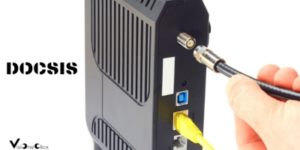 Cable or Hybrid Fiber Co-axial (HFC) business Internet providers
Cable or Hybrid Fiber Co-axial (HFC) business Internet providers
Price Guide: $80 to $500
Installation: $0 to $600
Contract terms: 1 to 3 years
Cable or Hybrid Fiber Coaxial (HFC) Internet access is the most ubiquitous form of Internet access offered by business Internet providers throughout North America. Initially developed for cable television, cable uses a combination of fiber optics and copper coaxial cable to deliver services. A fiber cable runs from the provider’s central office (head-end) to a node in the community to be serviced. Coax cable then connects customer premises from the node. Despite strong competition from fiber optic based solutions such as Fiber To The Home (FTTH), cable continues to evolve, taking advantage of the installed base. Data Over Cable Service Interface Specification (DOCSIS) version 3.1 specifies speeds of up to 10Gigbit/second (download) and 1-2Gigabit/s (upload). Version 4.0, which is still in the works, will enable symmetric speeds of 10Gigabit/s x 10Gigabit/s. However, 1Gigabit/s x 35Megabit/s is more readily available in most markets.
Cable business Internet providers typically offer their services in bundles that include TV and phone services. Businesses that offer TV to their customers such as property management companies, sports cafes and gyms tend to benefit the most from these bundles.
| Provider | Mini Speed | Max speed | States covered |
|---|---|---|---|
| Comcast Business | 25Megabit/s x 5Megabit/s | 1Gigabit/s x 35Megabit/s | Alabama, Arizona, Arkansas, California, Colorado, Connecticut, Delaware, District of Columbia, Florida, Georgia, Idaho, Illinois, Indiana, Kansas, Kentucky, Louisiana, Maine, Maryland, Massachusetts, Michigan, Minnesota, Mississippi, Missouri, New Hampshire, New Jersey, New Mexico, New York, North Carolina, Ohio, Oregon, Pennsylvania, South Carolina, Tennessee, Texas, Utah, Vermont, Virginia, Washington, West Virginia, Wisconsin |
| Spectrum Business | 200Megabit/s x 10Megabit/s | 1Gigabit/s x 35Megabit/s | Alabama, Arizona, Arkansas, California, Colorado, Connecticut, Florida, Georgia, Hawaii, Idaho, Illinois, Indiana, Kansas, Kentucky, Louisiana, Maine, Maryland, Massachusetts, Michigan, Minnesota, Mississippi, Missouri, Montana, Nebraska, Nevada, New Hampshire, New Jersey, New Mexico, New York, North Carolina, Ohio, Oregon, Pennsylvania, Rhode Island, South Carolina, Tennessee, Texas, Utah, Vermont, Virginia, Washington, West, Virginia, Wisconsin, Wyoming |
| Altice Optimum | 25Megabit/s x 5Megabit/s | 500Megabit/s x 50Megabit/s | Connecticut , New Jersey, New York, Pennsylvania |
| Cox Business | 5Megabit/s x 1Megabit/s | 500Megabit/s x 50Megabit/s | Arizona, Arkansas, California, Connecticut, District of Columbia, Florida, Georgia, Idaho, Iowa, Kansas, Louisiana, Massachusetts, Nebraska, Nevada, North Carolina, Ohio, Oklahoma, Rhode Island, Virginia |
| Wow! | 25Megabit/s x 5Megabit/s | 100Megabit/s x 10Megabit/s | Alabama, Florida, Georgia, Illinois, Indiana, Kansas , Michigan, Minnesota, Ohio, South Carolina South Dakota, Tennessee |
| Suddenlink | 25Megabit/s x 5Megabit/s | 100Megabit/s x 10Megabit/s | Arizona, Arkansas, California, Idaho, Illinois, Indiana, Kansas, Kentucky, Louisiana, Mississippi, Missouri, Nevada, New Mexico, North Carolina, Ohio, Oklahoma, Texas, Virginia, West Virginia, |
| Atlantic Broadband | 25Megabit/s x 5Megabit/s | 200Megabit/s x 10Megabit/s | Deleware, District of Columbia, Florida, Illinois, Maryland , Massachusetts, New York, Pennsylvania, South Carolina, Virginia |
| Cable One | 25Megabit/s x 5Megabit/s | 100Megabit/s x 10Megabit/s | Alabama , Arizona , Arkansas , Iowa , Kansas , Minnesota , Missouri , Nebraska, Oklahoma , Oregon, South Dakota, Tennessee, Texas , Washington |
Why go through FiberGuide for business Internet providers?
First, you can go through our free, convenient and easy to use online carrier services research tool (GeoQuote) to search solutions nearest to you. For selected services such as T1 Internet, Ethernet over Cable and business cable, you can instantly view hundreds of packages and prices from multiple providers. You will have the option to let us know if you need an email or phone follow-up or if you are just window shopping and don’t need to be contacted.
If you need our support, a product specialist will work with you to match your requirements with the most relevant business Internet providers. Because we have a relationship with all these providers, we are well positioned to negotiate the best pricing for you. You can consider us a free resource for you during the procurement process and through implementation.





